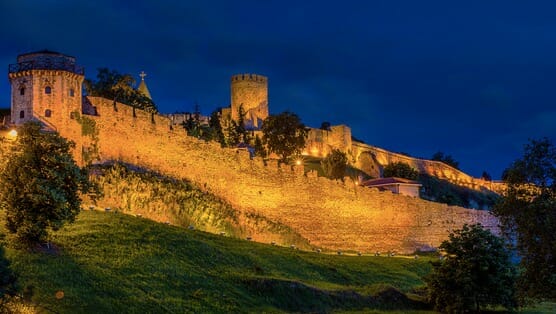Greetings From Belgrade, Serbia

Belgrade has most of the trappings of an evolving magnet for hip travelers: a riverfront medieval fortress, historic shop-lined avenues, and former industrial zones that have become a lure for creative types. But the thing that makes the capital of Serbia, which started European Union accession talks in January 2014, special is that it brandishes a boastful and freewheeling energy while retaining (or as a result of) its enduring grit. Even after being destroyed and rebuilt some 40 times—after decades of sanctions, war and NATO bombings—the Balkan metropolis of 1.4 million entices visitors to partake in a new design district, barges repurposed as bars on the banks of the Danube and Sava rivers, café culture and partying long past zora, the Serbian word for dawn.
Day One
Morning
Belgrade’s central hub is Republic Square, where young people wait for their mates at the equestrian statue of Prince Mihailo, which celebrates the end, in 1867, of 500 years of Ottoman rule. Framed by the National Museum and National Theater, it is a great place to get a feel for the city’s diversity and a starting point for strolling down Knez Mihailova, the main pedestrian zone flanked with cafes and boutiques. Stop in at Leila, a coffee shop and record store, for a morning jolt or have a full breakfast at Snjezana or, a bit further afield, micro-roastery Przionica, which means little roaster.
Knez Mihailova culminates in Kalemegdan, the city’s imposing medieval fortress built atop the foundations of Singidunum, a Roman settlement. Its location, at the confluence of the Sava and Danube rivers, makes it a lovely place for sunset. Before that, make sure you check out the structures left behind by Roman, Ottoman and Austro-Hungarian occupations. If you’re a history enthusiast, check out the military museum, including an exhibit about the 1999 NATO bombing of Serbia.

Kalemegdan FortressPhoto: Flickr/Goran Joka
Afternoon
Do not miss the Underground Belgrade tour. You’ll learn about Belgrade’s long history by visiting its hidden subterranean treasures, which include sites from its Roman, Turkish, Austrian, Yugolsavian and Serbian eras.
After the history lesson, head to Belgrade’s “Sillicon Alley,” as locals refer to Strahinjic Ban Street, if for no other reason than to witness the effort Belgrade women put into their appearances. The street is lined with Belgrade’s nouveau riche, fancy cars, and a smattering of good restaurants and bars for people watching. Try the mod Supermarket, a restaurant serving an array of updated Serbian food and sushi with a full bar that also, curiously, sells the wares of Serbian designers. Or check out the nearby Smokvica, a little café serving mezze (a light meal) and a few Asian-inspired snacks in a homey environment that spills out to what was until recently a disused courtyard next to Belgrade’s Jewish Historical Museum.
Silicon Alley ends at Skadarlija, a quaint pedestrian avenue preserved as the city’s fin de siècle Bohemian quarter. The cobblestoned hill is teeming with traditional Serbian restaurants, or kafanas, where you can try muckalica, a pork and pepper stew and cevapi, or minced grilled meat, a Balkan staple. Locals request their favorite folk songs from roving troubadours playing traditional ballads until the early morning. Patrons who want to give the musicians a bit of baksheesh (a tip) do so by rolling up bills lengthwise and sliding them into the strings of the bass or into the folding part of the accordion. The food and prices are comparable in many of the establishments, so you can dine (with wine, beer or schnapps, known as rakija) for about less than 3,400 Serbian Dinars (or around $34 at 98.9 SRD to the dollar), but the best decor is at Dva Jelena and the best music is at Zlatni Bokal.
After Midnight
It’s time to hit the splavs, Serbia’s barge boats on the Sava river, across Brankov Bridge, where the party doesn’t start in earnest until after midnight. Each has its own character, and with cover prices of approximately one euro you can afford to try them all. Hipsters head to Klub 20/44, while Klub Schlep, an old cargo boat, plays top-40 hits. The adventurous head to Jimmy’s, where singers croon Turbo-folk songs—a fusion of folk and electronic synth—until past four in the morning. You might see some of the very same polished people from Silicon Alley letting loose here. Be warned, Serbia has no indoor smoking ban, so prepare your lungs in advance.

Klub 20/44Photo: FlickrSHARE Conference
Day Two
-

-

-

-

-

-

-

-

-

-

-

-

-

-

-

-

-

-

-

-

-

-

-

-

-

-

-

-

-

-

-

-

-

-

-

-

-

-

-

-









































